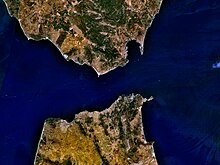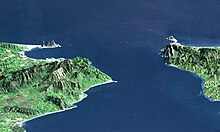Strait of Gibraltar crossing

The Strait of Gibraltar crossing is a hypothetical bridge or tunnel spanning the Strait of Gibraltar (about 14 km or 9 miles at its narrowest point) that would connect Europe and Africa. The governments of Spain and Morocco appointed a joint committee[1] to investigate the feasibility of linking the two continents in 1979, which resulted in the much broader Euromed Transport project.[2]
In January 2021, it was reported that the United Kingdom and Morocco would discuss building the crossing between Gibraltar and Tangiers.[3] As of 2023, the completion of Morocco's first national high-speed rail line from Casablanca to Tangiers has led to renewed interest in a tunnel that would connect the line to Spain's own high-speed network, which uses the same gauge and electrification as the northern section of Morocco's Casablanca-Tangier high-speed line.[4]
Bridge
[edit]Several engineers have designed bridges on various alignments and with differing structural configurations. A proposal by Professor T.Y. Lin for a crossing between Point Oliveros and Point Cires featured deep piers, a length of 14 kilometres (9 miles), 910-metre-tall (3,000 ft) towers, and a 5,000-metre (16,000-foot) span, more than twice the length of the current longest bridge span.[5] According to OPAC this bridge would have cost around US$15 Billion.[5] A 2004 proposal by architect Eugene Tsui was for a floating and submerged bridge connected at a three-mile-wide (4.8 km) floating island in the middle of the Mediterranean Sea.[6]
Tunnel
[edit]Various tunnels have been proposed. Spain first proposed a modern tunnel under the Strait of Gibraltar in 1930. A major problem arose when the engineers hired by the Spanish government discovered that the material under the Strait was extremely hard rock, making tunnelling impossible with the available technology.[7] One engineering solution was to fix, using cables, a prefabricated concrete tunnel to the floor of the Strait. This tunnel would handle automotive and train traffic.[8]
A 2008 geological study cast doubt on the tunnel's feasibility. In March 2009, a contract was issued for a joint system linking the Moroccan Société Nationale d'Etudes du Détroit de Gibraltar (SNED) with its Spanish counterpart, Sociedad española de estudios para la comunicación fija a través del Estrecho de Gibraltar SA (SECEGSA). A three-year study for a railway tunnel was announced in 2003. SNED and SECEGSA commissioned several seabed surveys.
The Strait is up to 900 metres (3,000 ft) deep on the shortest route, but only about 300 metres deep slightly further west, in a region known as the Camarinal Sill; the European and African tectonic plates meet around this area. The shortest crossing is 14 kilometres (8.7 mi). The proposed route of 23 kilometres (14 mi) is west of Tarifa and to the east of Tangier. The tunnel is likely to be about 34 kilometres (21 miles) in all. It is proposed that a connection would have to be made to the Spanish high speed railway network, which has a line projected to be built from Cádiz to Málaga via Algeciras.
A report[9][10][11] on the feasibility of the tunnel was presented to the EU in 2009. A further project study is under development by a group of specialist consultants from SYSTRA, Amberg and COWI.[citation needed]
Planning
[edit]
The political origins of the project arise from the Common Hispanic-Moroccan Declaration of Fez, of 16 June 1979, and signed by the kings of Spain and Morocco.[12] One consequence of the declaration was the creation in 1981 of SECEGSA, the Spanish government-funded corporation tasked with studying and promoting the crossing.[13]
In December 2003, Spain and Morocco agreed[14][15] to explore the construction of an underwater rail tunnel to connect their rail systems. The tunnel would have linked Cape Malabata near Tangier with Punta Paloma in the El Estrecho Natural Park 40 kilometres (25 mi) west of Gibraltar.[16] In late 2006, Lombardi Engineering Ltd, a Swiss engineering and design company, was retained to draft a design for a railway tunnel.[17] According to the company, the main differences between the construction of this tunnel and that of the Channel Tunnel, linking France and Great Britain, are the depth of the sea and the geological conditions. The area under the Strait is less stable than that under the English Channel. An active major geologic fault, the Azores–Gibraltar Transform Fault, bisects the Strait, and severe earthquakes have occurred in the area. The presence of two deep Quaternary clay channels in the middle of the Strait makes construction complex,[9] causing doubts about the feasibility of the project and proposals for an exploratory tunnel.[18]
No official figures about the cost of the project had been announced by 2007, but previous estimates exceeded €5 billion.[19]
In February 2023, after a high-level bilateral meeting between Spain and Morocco, the Moroccan and Spanish governments resolved to relaunch the project for an undersea railway tunnel under the Strait of Gibraltar. The project is planned to start construction in 2030.[20] In June 2023, the Spanish government announced a €2.3 million funding package for a joint Spanish-Moroccan design and planning committee for the tunnel. The tunnel would connect the southern end of Spain's national high-speed train network with the northern end of the recently constructed Al Boraq high-speed line from Casablanca to Tangiers—the first high-speed rail line in Africa.[4]
Technical aspects
[edit]The proposed rail tunnel's length is 40 kilometres (25 mi), 300 metres (980 ft) deep,[10] and its construction would take 15 years. An earlier plan was to link the two continents via the narrowest part of the strait, but this idea was dismissed as the tunnel would be 900 metres (3,000 ft) below sea level. For comparison, the currently deepest undersea tunnel, the Norwegian Ryfylke Tunnel, is 291 metres (955 ft) below sea level. A tunnel deeper than Ryfylke is under construction, also in Norway; Rogfast will be 27 kilometres (17 mi) long and 392 metres (1,286 ft) deep, expected to be completed in 2028–29.
The construction of terminals, similar to the Eurotunnel Folkestone Terminal and Eurotunnel Calais Terminal at either end of the Channel Tunnel, might be required for transshipment of road vehicles.
Ferry
[edit]Car ferries have long operated across the Strait of Gibraltar. As of 2023[update] they operate on these routes:[21]
The ferry traffic has an established base of customers, useful to calculate the number of users for a fixed link.
See also
[edit]- Atlantropa
- Bridge of the Horns
- Extreme Engineering
- Marmaray
- Morocco–Spain border
- Morocco–Spain relations
- Transport in Morocco
- Transport in Spain
- Intercontinental and transoceanic fixed links
- Floating cable-stayed bridge
- Cable-stayed suspension bridge
- Maghreb-Europe Gas Pipeline – Natural gas pipeline linking Africa and Europe
References
[edit]- ^ "Portail national du Maroc". Archived from the original on 4 April 2012. Retrieved 22 December 2012.
- ^ Euromed Transport project 2003 – 2009[failed verification]
- ^ "UK and Morocco may discuss a tunnel linking Gibraltar and Tangiers". 11 January 2021.
- ^ a b "High-speed rail tunnel to link Europe to Africa gets EU funding". The Independent. 16 June 2023. Retrieved 16 June 2023.
- ^ a b "Gibraltar Bridge – Feasibility Study". OPAC Consulting Engineers. 2003. Retrieved 5 March 2009.
- ^ "Strait of Gibraltar Floating Bridge". Tsui Design & Research, Inc. 2004. Archived from the original on 7 October 2022. Retrieved 5 March 2009.
- ^ "Tunnel from Spain to Africa". Popular Mechanics. March 1930. p. 366. Retrieved 28 January 2023 – via books.google.com.
article bottom-left
- ^ "Strangest Tunnel to Join Europe and Africa". Popular Mechanics. August 1930. Retrieved 28 January 2023 – via books.google.com.
- ^ a b "Project of the fixed link through the strait of Gibraltar" (PDF). SECEG SA. November 2007. Archived from the original (PDF) on 19 February 2009. Retrieved 3 February 2009.
- ^ a b Wood, Danny (19 July 2008). "Spain-Africa link decision 'near'". BBC News. Retrieved 20 July 2008.
- ^ "El proyecto del túnel del Estrecho llegará en 2009 a manos de la UE en busca de apoyos" [The Strait tunnel project will reach the hands of the EU in 2009 in search of support]. 20 minuto.es (in Spanish). 16 November 2008. Retrieved 3 February 2009.
- ^ "Marco Institucional" [Institutional Framework]. SECEGSA (in Spanish). Government of Spain – SECEGSA. Retrieved 31 May 2018.
El Proyecto de Enlace Fijo a través del Estrecho de Gibraltar tiene sus orígenes en la Declaración Común Hispano-Marroquí, fechada en Fez el 16 de junio de 1979, mediante la cual, los reyes Hassan II de Marruecos y Juan Carlos I de España, conscientes de la importancia que en el futuro tendrían las relaciones entre los dos países y entre Europa y África, pusieron de manifiesto su deseo de trabajar conjuntamente en el desarrollo de dicho Proyecto.
[The Fixed Link Project through the Strait of Gibraltar has its origins in the Spanish-Moroccan Common Declaration, dated in Fez on June 16, 1979, through which King Hassan II of Morocco and King Juan Carlos I of Spain, aware of the importance that relations between the two countries and between Europe and Africa would have in the future, expressed their desire to work together in the development of said Project.] - ^ "Estatutos de la Sociedad Anónuma Denominada: Soviedad Española de Estudios para la Comunicación fiha a través del Estrecho de Gibraltar, S.A. (SECEGSA)" [Statutes of the Public Limited Company Named: Sociedad Española de Estudios para la Comunicación fiha a través del Estrecho de Gibraltar, S.A. (SECEGSA)] (PDF). SECEGSA (in Spanish). Government of Spain – SECEGSA. p. 1. Retrieved 31 May 2018.
La duración de la Sociedad será por tiempo indefinido, habiendo dado comienzo sus operaciones el día 26 de febrero de 1981, fecha del otorgamiento de la escritura de constitución.
[The duration of the Company will be for an indefinite period, having started its operations on February 26, 1981, the date of the execution of the deed of incorporation.] - ^ "Europe-Africa rail tunnel agreed". BBC News. 14 December 2003. Retrieved 3 February 2009.
- ^ "Africa and Europe set for tunnel link". BBC News. 13 March 2007. Retrieved 3 February 2009.
- ^ "Spain and Morocco agree to rail tunnel under Gibraltar strait". wsws.org. 5 January 2004. Retrieved 10 January 2007.
- ^ "Swiss plan tunnel under Strait of Gibraltar". swissinfo.org. Retrieved 10 January 2007.
- ^ "Doubts cast over tunnel plan". Middle East Online. 29 September 2008. Retrieved 3 February 2015.
- ^ Tremlett, Giles (20 October 2006). "By train from Europe to Africa – undersea tunnel project takes a leap forward". The Guardian. London. Retrieved 10 January 2007.
- ^ Aamari, Oussama. "Morocco, Spain Relaunch Gibraltar Strait Tunnel Project". www.moroccoworldnews.com/. Morocco World News. Retrieved 14 February 2023.
- ^ Ferries from Spain to Morocco 2023
"Website of the project of the fixed link through the Strait of Gibraltar". Archived from the original on 16 May 2007. Retrieved 3 February 2009.
External links
[edit]- Strait of Gibraltar
- Proposed bridges in Europe
- Transport in Spain
- Transport in Morocco
- International tunnels
- Railway tunnels in Spain
- Proposed transcontinental crossings
- Proposed undersea tunnels in Europe
- Proposed undersea tunnels in Africa
- Buildings and structures in Tanger-Tetouan-Al Hoceima
- Proposed railway tunnels in Africa
- Proposed railway tunnels in Europe
- Proposed bridges in Africa
- Morocco–Spain border
- Morocco–Spain relations
- Proposed rail infrastructure in Spain
- Proposed rail infrastructure in Morocco

